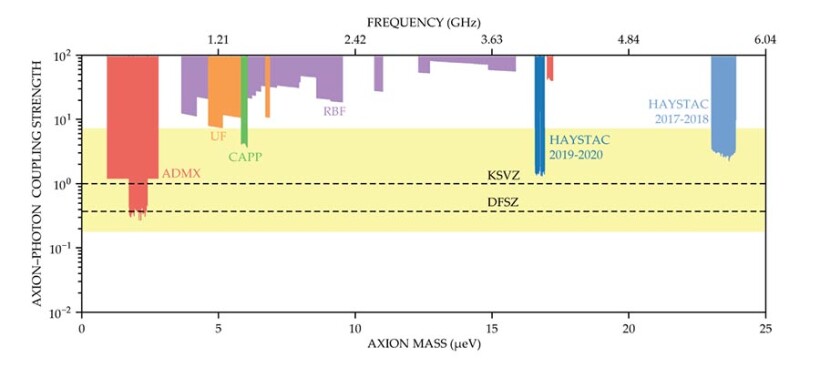A squeezed-light axion search is up and running
In the quantum world, uncertainty is everywhere. No particle is ever completely still, no vacuum completely empty, no darkness completely devoid of light, no measurement perfectly precise.
But quantum uncertainty can often be shifted between pairs of variables. The Heisenberg uncertainty principle places a lower bound not on the uncertainty of a particle’s position nor its momentum, but on the product of the two. It’s possible, therefore, to reduce one of those uncertainties at the expense of increasing the other.
Likewise, electromagnetic waves are subject to quantum uncertainty, but the uncertainty needn’t be evenly distributed over the wave period. One can shift the uncertainty from the part of the wave cycle one wants to measure to a part that’s irrelevant to the measurement. Those so-called squeezed states of light can be realized by nonlinear optical devices.
Squeezed light has been used to heighten LIGO’s (Laser Interferometer Gravitational-Wave Observatory’s) sensitivity to gravitational waves (see Physics Today, November 2011, page 11
Axions, if they exist, are extremely light: less than a billionth the mass of the electron. Still, if they’re sufficiently abundant, they could have enough collective gravitational heft to influence galaxy rotation and bend light rays—the observable evidence of dark matter’s existence.
Unlike some other putative dark-matter particles, axions can couple to photons. The coupling is the basis for HAYSTAC’s detection scheme: Axions interact with the virtual photons of a strong magnetic field and transform into real photons, which are then detected.
For researchers to have any hope of finding a signal that way, they amplify the axion–photon coupling in a resonant cavity. Searching for axions, then, is like tuning a radio: At any given time, the experiment is sensitive only to a particular needle-thin range of photon frequencies and the corresponding axion masses. And theorists have little idea what the axion mass actually is: The range of possible masses spans orders of magnitude.
With an experiment subject to the standard quantum noise limit—without any uncertainty shifting—searching that whole range would take millennia. Even with several experiments on the case, researchers have so far only nibbled at the parameter space, shown in yellow in the figure, of likely axion masses and axion–photon coupling strengths.

Adapted from K. M. Backes et al., Nature 590, 238 (2021)
A few years ago, the HAYSTAC researchers modified their experiment to look for an axion signal on top of a squeezed electromagnetic state, with their detector tuned to measure the part of the state with reduced uncertainty. (For more details of their scheme, see the article by Karl van Bibber, Konrad Lehnert, and Aaron Chou, Physics Today, June 2019, page 48
The researchers haven’t seen any axions yet, but from just a few months of data collection in late 2019 and early 2020, they’ve already excluded the region shown in dark blue in the figure. As new quantum technologies become available to axion detectors, they hope to boost their scanning speed to more than 10 times the quantum limit. (K. M. Backes et al., Nature 590, 238, 2021